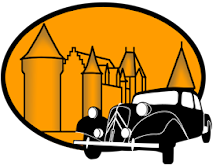If you can provide several good quality photos the experts on the HymIS and BWARS forums may be able to identify your Megachilidae, but many are difficult from photos.
Mason and Orchard Bees Osmia spp:
For information about some common Osmia species, see a post on Days on the Claise, with photographs of European Orchard Bee O. cornuta and Red Mason Bee O. rufa. For further information, with good photos and some great observations, see Bees in a French Garden.
European Orchard Bee Osmia cornuta
See post on Days on the Claise for further information, including photographs of male. Below, a female investigates the possibilities of drainage hole in our back door as a potential nest hole, April.

Mason, Potter or Wool Carder Bees Anthidium spp:
Anthidium spp are striking black and yellow bees, very active and fast moving and the males are aggressively protective of their territory, driving off all other insects (they are not threatening towards people though). There are a number of very similar species here. Like all Megachilids they collect pollen on special hairs on their bellies (clearly visible in the photo above). In some species the females also collect balls of fluff by scraping it off the undersides of vine leaves or from woolly plants such as Lambs Ears Stachys. The fluff is used to line nest holes. You can see a photo of a nest here, on Aigronne Valley Wildlife. Other species line the nest with pine resin. Unusually for a bee species, male Anthidiums are bigger than the females. Bees in a French Garden has a good entry on Anthidiums if you want further information.








Thanks for the link Susan...
ReplyDeleteI'll just mention that it is the last picture...